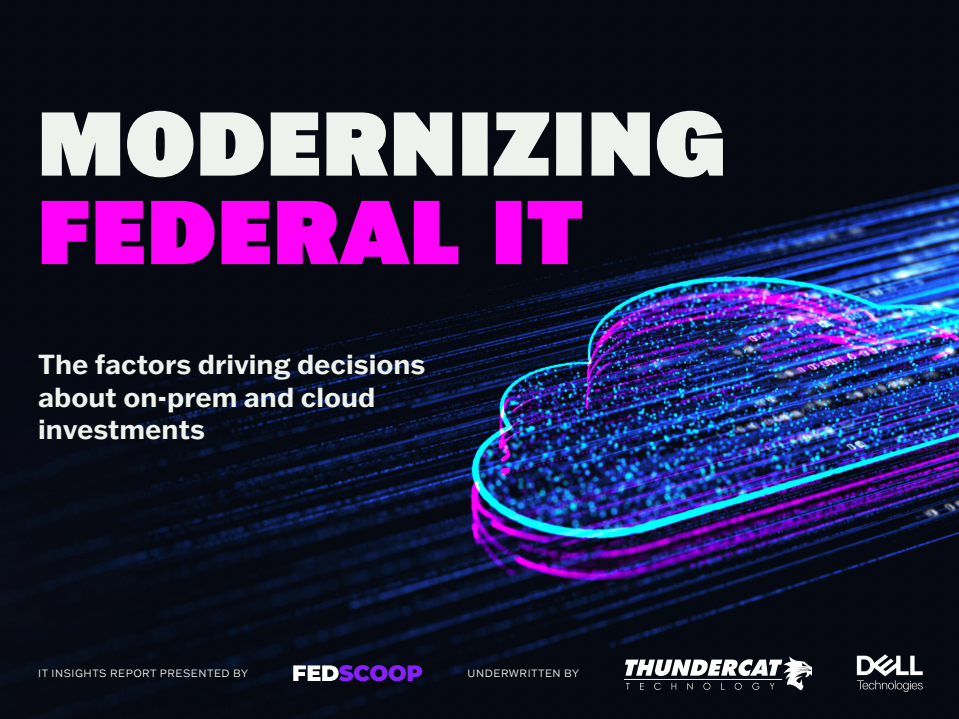- Sponsored
- Modernization
Government clouds now handle more IT work than federal data centers

Government-approved cloud services have taken the lead over on-premises data centers for critical computing workloads at federal agencies, according to a new FedScoop survey of federal IT officials.
Agencies still rely on multiple IT environments for executing, storing and backing up critical computing workloads that are central to agency operations. But more federal officials (31%) now say they are executing a majority of their critical workloads on government-approved cloud platforms than in their own agency-operated data centers (28%).

The reliance on cloud services continues to gain momentum.The volume of critical computing workloads operating on government-dedicated cloud services grew faster over the past 12-18 months, according to nearly half (47%) of survey respondents, compared to workloads run in agency-owned/operated data centers (28%). And nearly twice as many respondents (56%) are looking at government-approved cloud platforms to increase hardware capacity over the next three years compared to agency-owned/operated data centers (33%).
The findings are part of a new report aimed at understanding the latest views of federal IT executives in modernizing their IT infrastructure — and the benefits and challenges they see in updating on-premises data centers versus deploying workloads to the cloud. The FedScoop study reflects the views of 169 prequalified federal agency IT decision-makers and program managers in an online survey conducted in February-March 2022.
The study, conducted with underwriting support from ThunderCat Technology and Dell Technologies, takes a fresh look at which type of platforms agencies are relying on to execute, store and back up critical workloads and what’s driving their investment decisions over the next three years.
Key takeaways
The need for greater agility and adaptability — together with pressures to modernize legacy systems and narrow lingering skills gaps — continue to drive agencies toward wider adoption of cloud services.
At the same time, as original equipment manufacturers continue to develop advanced, software-defined servers — and offer more flexible financing and IT-as-a-service models that support cloud-like consumption — agencies now have more computing options, noted Wyatt Kash, senior vice president of content strategy for Scoop News Group, which produced the study for FedScoop.
Among the key findings from the study:
Data and security emerge as top drivers of IT investments. The need to secure data moving across multiple environments was cited by 58% of federal IT and program leaders surveyed as the top factor driving their infrastructure investment decisions over the next three years. But also driving investments are the anticipated overall growth of agency data (50%) and the need to analyze data in real-time (38%).
Cloud’s strengths seen outweighing on-prem computing. A majority of respondents overall believe cloud services offer greater operational advantages over on-prem environments. But the study detected a disconnect between C-suite and program leaders and IT executives. A greater proportion of IT executives compared to C-suite leaders, for instance, believe on-premises servers deliver better security control and application performance than cloud service providers. C-suite leaders, conversely, believe more than IT executives that cloud services offer greater cost advantages and better service delivery to citizens than on-prem servers. The differences in perspectives, however, can lead to delays in modernizing, making it important that C-suite and IT leaders come to a clearer mutual understanding of advancing technology capabilities, the study suggested.
Spending on edge computing is gaining ground. Four in 10 respondents expect their agencies will spend 20% or more annually on-premises IT investments on edge computing capabilities three years from now, compared to fewer than 2 in 10 respondents whose agencies invest at the level now.
Server advances have agencies rethinking on-prem IT strategy. Nearly half of respondents perceive recent advances in the manageability, performance, and lower costs of modern enterprise servers as justifying reinvesting in on-premises servers. About 1 in 5 respondents said their agencies had moved certain workloads back on-premises from the cloud. Nearly half of that subgroup says the key reason is “performance of modern on-prem servers is comparable to the cloud.”
As is usually the case, perceptions varied depending on the size of agencies where respondents work, based on employee counts. A greater proportion of respondents at large and midsized agencies, for instance, believe that on-premises servers have the advantage over cloud services in offering stronger security control; those at smaller-sized agencies believe cloud services have the edge over on-prem infrastructure.
Similarly, the need to serve a more distributed workforce, and collect and analyze data at the network edge, played a larger-than-average role in driving IT investments at smaller-sized agencies compared to larger agencies.
The study concluded that as modernized data center servers achieve closer parity with cloud platforms, agencies may need to readjust their calculus in defining which workloads function best on-premises versus the cloud and, in turn, rework the assumptions underlying their hybrid and multi-cloud strategies.
This article was produced by Scoop News Group for FedScoop and underwritten by ThunderCat Technology and Dell Technologies.






